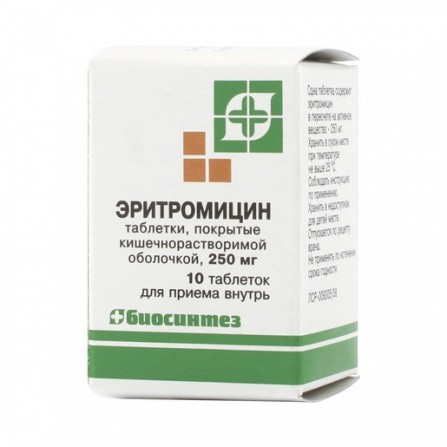Erythromycin coated pills 250mg N10
Condition: New product
1000 Items
Rating:
Be the first to write a review!

More info
Active ingredients
Erythromycin
Release form
Pills
Composition
1 tablet contains: erythromycin 250 mg. Supplementary substances: povidone - 9.45 mg, crospovidone - 13.5 mg, calcium stearate - 4.14 mg, talc - 10.35 mg, potato starch - up to a kernel weight of 450 mg. Composition of the shell: 16.2 mg cellulose, titanium dioxide 0.8 mg, castor oil 3 mg
Pharmacological effect
An antibiotic group macrolides. It has a bacteriostatic effect. However, in high doses in relation to sensitive microorganisms has a bactericidal effect. Erythromycin reversibly binds to the ribosomes of bacteria, thereby inhibiting protein synthesis. Active against gram-positive bacteria: Staphylococcus spp. (strains producing and not producing penicillinase), Streptococcus spp. (including Streptococcus pneumoniae); Gram-negative bacteria: Neisseria gonorrhoeae, Haemophilus influenzae, Bordetella pertussis, Brucella spp., Legionella spp., Bacillus anthracis, Corynebacterium diphtheriae; anaerobic bacteria: Clostridium spp. Erythromycin is also active against Mycoplasma spp., Chlamydia spp., Spirochaetaceae, Rickettsia spp. Gram-negative rods are resistant to erythromycin, including Escherichia coli, Pseudomonas aeruginosa, Shigella spp., Salmonella spp.
Pharmacokinetics
Bioavailability is 30-65%. Distributed in most tissues and body fluids. Plasma protein binding is 70-90%. Metabolized in the liver, partly with the formation of inactive metabolites. T1 / 2 - 1.4-2 hours. Derived from the bile and urine.
Indications
Infectious and inflammatory diseases caused by microorganisms sensitive to the drug, including: - diphtheria; - whooping cough; - trachoma; - brucellosis; - Legionnaires disease; - sore throat; - scarlet fever; - infections of ENT organs (tonsillitis, otitis media, sinusitis); - infections of biliary tract (cholecystitis); - infections of the upper and lower respiratory tract (tracheitis, bronchitis, pneumonia); - infections of the skin and soft tissues; - gonorrhea; - Syphilis; Treatment of infectious and inflammatory diseases caused by pathogens (in particular Staphylococcus spp.) resistant to penicillin, tetracycline, chloramphenicol, streptomycin.
Contraindications
Hypersensitivity, jaundice (in history), hepatic and / or renal failure, concomitant use of terfenadine or astemizole.
Precautionary measures
With caution used for violations of the liver, kidneys.
Use during pregnancy and lactation
Erythromycin penetrates the placental barrier, is excreted in breast milk. When using erythromycin during pregnancy, the expected benefits to the mother and the potential risk to the fetus should be assessed.If necessary, use during lactation should decide on the termination of breastfeeding.
Dosage and administration
Tablets administered by mouth for 1-1.5 hours before a meal or 2-3 hours after a meal. Single dose for adults 0.25 g, for serious diseases - 0.5 g. Accept every 4-6 hours. The highest single dose for adults - 0.5 g, daily - 4 g. Children under the age of 3 months prescribed in the dose at the rate of 20-40 mg / kg per day; at the age of 4 months to 18 years - 30-50 mg / kg per day. The multiplicity of appointments - 4 times. The course of treatment is 5-14 days; after the disappearance of the symptoms of the disease, the drug is prescribed for another 2 days. The duration of treatment depends on the form and severity of the disease and is 5-14 days.
Side effects
Possible: abnormal liver function, nausea, vomiting, epigastric pain, skin allergic reactions. Rarely: cholestatic jaundice, anaphylactic shock. Local reactions: hyperemia, burning, itching, irritation and peeling of the skin; irritation of the mucous membrane of the eye, blurred vision.
Overdose
Symptoms: abnormal liver function, up to acute liver failure, and hearing loss. Treatment: gastric lavage, forced diuresis, hemo-and peritoneal dialysis. Constant monitoring of vital functions (ECG, electrolyte composition of blood) is performed.
Interaction with other drugs
With simultaneous use of erythromycin with theophylline, aminophylline, caffeine, an increase in their plasma concentration is noted and thus increases the risk of toxic action. Erythromycin increases the concentration of cyclosporine in the blood plasma and may increase the risk of nephrotoxic action. The drugs blocking tubular secretion, prolong T1 / 2 erythromycin. Incompatible with lincomycin, clindamycin and chloramphenicol (antagonism). Erythromycin reduces the bactericidal effect of beta-lactam antibiotics (ne nicillins, cephalosporins, carbapenems). With simultaneous use, erythromycin increases theophylline content. When used simultaneously with drugs that are metabolized in the liver (carbamazepine, valproic acid, hexobarbital, phenytoin, alfentanil, disopyramide, lovastatin, bromine, bromide, hexobarbital, phenytoin, alfentanil, disopyramide, lovastatin, bromine, phenomeric acid, hexobarbital, phenytoin, disopyramide, lovastatin, isopropanol, bromobutane, phenytoin, alfentanyl, disopyramide, lovastatin, bromine, bromide, phenylointhe concentration of these drugs in plasma may increase (it is an inhibitor of liver microsomal enzymes). Into / into the administration of erythromycin, it enhances the effect of ethanol (accelerating gastric emptying and reducing the duration of action of alcohol dehydrogenase in the gastric mucosa). Erythromycin reduces the clearance of triazolam and midazolam and therefore may increase pharmacological effects benzodiazepines. When taken simultaneously with terfenadine or astemizole, arrhythmias may develop (flicker and flutter of the ventricles, ventricular tachycardia, even death); With a snoods
special instructions
Drugs that increase the acidity of gastric juice, and acidic drinks inactivate erythromycin. Erythromycin can not drink milk and dairy products.




